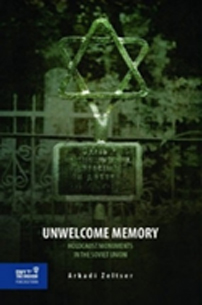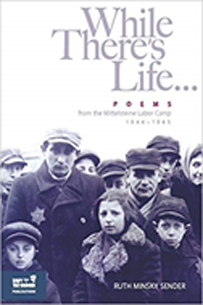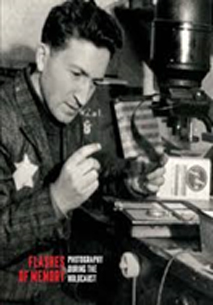Unwelcome memory
By Zelster, Arkadi
Yad Vashem, 2018
Unwelcome Memory: Holocaust Monuments in the Soviet Union examines the connection between the memory of the Holocaust in the USSR and the ethnic identity of Soviet Jews. It demonstrates that the Holocaust memorial culture of the Soviet Jews was very different and more diverse than was widely assumed, and presents a new perspective on the functioning of the Soviet system. The relatively large number of monuments reflects the ambivalent situation in the Soviet state— approval of the monuments depended no less on the local authorities’ positions in each instance than on general Soviet policy.
Thousands of Jews, men and women alike, from various parts of the USSR and different social and educational strata, banded together in more than 700 separate groups and organized semi-formal, mass, grassroots activities to memorialize their loved ones murdered by the Nazis and their local collaborators. Although most were loyal Soviet citizens, the memory of their relatives outweighed the considerations of circumspection required under the conditions of the totalitarian state.
About 100 of the monuments established by these groups include clear ethnic–religious inscriptions in Hebrew, Yiddish, and Russian, as well as Jewish symbols. Thus, Holocaust memorial practices became the main public expression of these activists’ commitment to traditional Jewish values, which symbolized their identification with those killed. The rich and manifold photographs in this book reflect the diversity of the memorialization forms and the ethnic message that Soviet Jews sought to transmit to other Jews and to generations to come.
While There's Life…
Poems from the Mittelsteine Labor Camp 1944-1945
By Ruth Minsky Sender
Yad Vashem, 2018
Surviving one more day in the camps was spiritual resistance. The poems in this collection were written by Riva Minska (Ruth Minsky Sender) during her incarceration as prisoner #55082 in the Nazi slave labor camp in Mittelsteine, Germany. She wrote them in little notebooks while hiding in her bunk. Every Sunday, she would read these moving verses aloud to the 50 other women in the room. They were her critical and faithful audience. She endeavored to depict scenes from their lives-their anguish, their pain and their longings-to give everyone a little courage and the will to continue. As her mother, Nacha Minska, used to say: “While there’s life, there’s hope.” This was how they spent their Sundays, and anyone who had a bit of talent did their best to bring a little happiness into their tragic lives.
Flashes of Memory: Photography during the Holocaust
Head Curator: Vivian Uria
Yad Vashem, 2018
Visual documentation is one of the major factors in shaping historical awareness of the Holocaust. Alongside archival documentation of the period’s events and the research on these records, visual documentation has contributed significantly towards knowledge of the Holocaust, influenced the manner in which it has been analyzed and understood, and affected the way it has been engraved in the collective memory. The camera, with its manipulative power, has tremendous impact and far-reaching influence. Although photography purports to reflect reality as it is, it is essentially an interpretation of it, since elements such as worldview, values, and moral perception influence the choice of the object to be photographed as well as how it is presented. When visual documentation is also used as a historical document, its use requires attributing the greatest of importance to these components. Different agencies photographed during the Holocaust. For the Nazi German regime, photography and film-making played a crucial role in propaganda as a means of expression and a tool for manipulating and mobilizing the masses. This kind of documentation attests to Nazi ideology and how German leaders sought to mold their image in the public eye. Conversely, Jewish photography was a component in the struggle for survival of the Jews imprisoned in the ghettos, and a manifestation of underground activity that testified to their desire to document and transmit information on the tragedy befalling their people. The Allied armies, who understood the informational value of photographing the camps they liberated, documented the scenes revealed to them, bringing in official photographers and encouraging soldiers to commemorate the Nazi horrors as evidence for future war crimes trials and in an effort to re-educate the German population. This exhibit presents a critical examination of documentation through the camera lens, focusing on the circumstances of the photograph and the worldview of the photographer, while referring to the Jewish photographers’ different and unique viewpoints as direct victims of the Holocaust.









